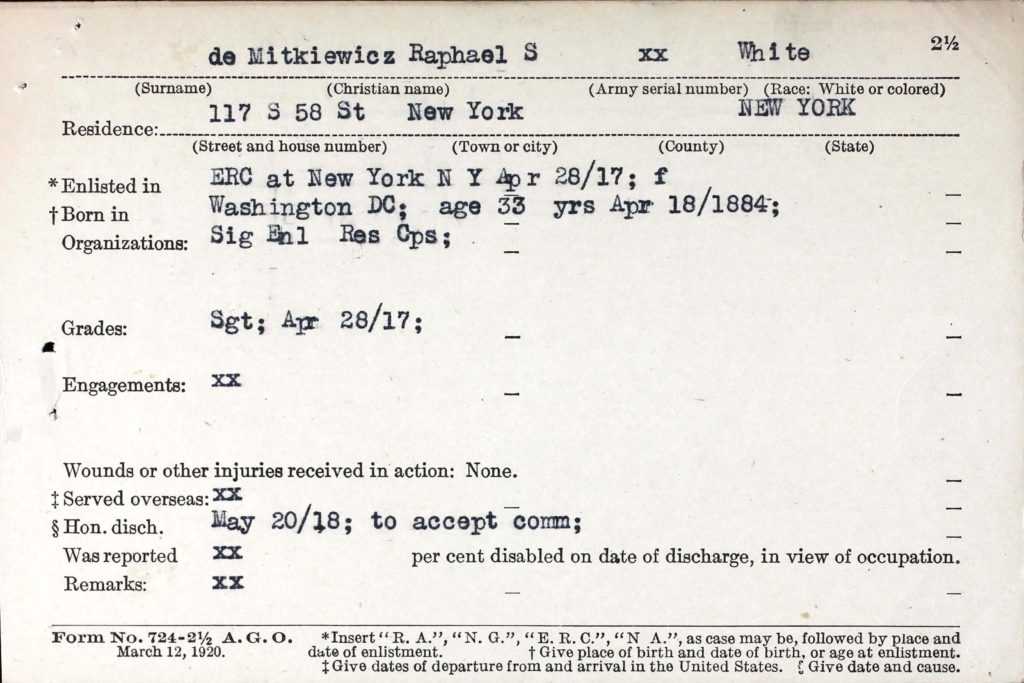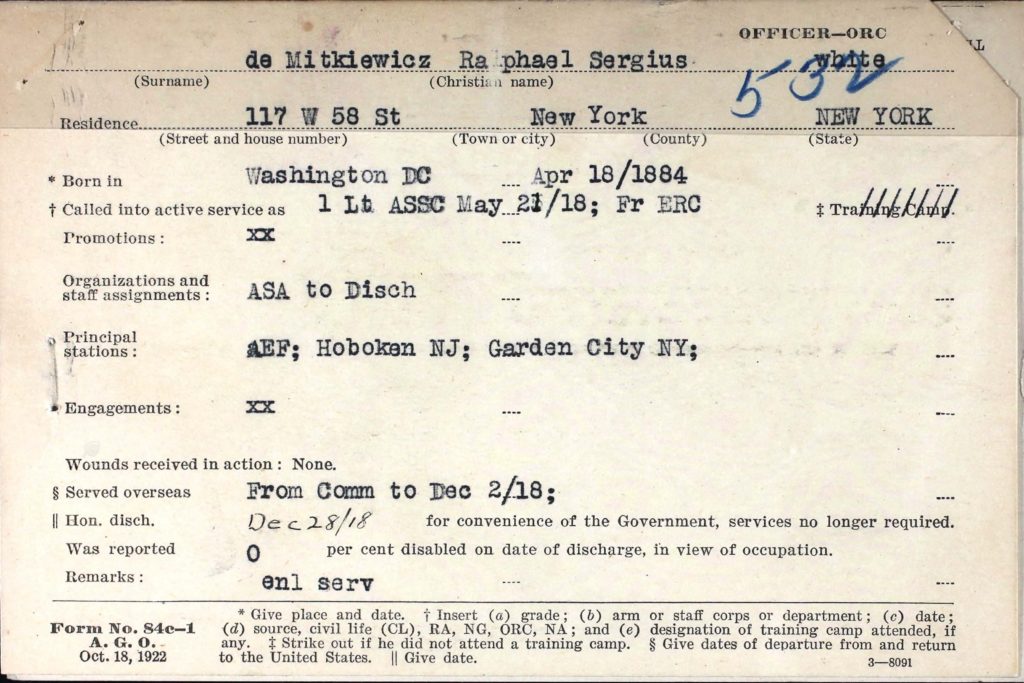(Washington, D.C., April 18, 1884 – New York City, May 30, 1946).1
De Mitkiewicz was the son of “Count” Eugene Stanislaus Kostka de Mitkiewicz, a rather remarkable Russian or Polish con man who arrived in the U.S. in 1870 and two years later married the daughter and only child of a wealthy Rochester, N.Y., banker. Raphael Sergius was the youngest of their nine children.2
De Mitkiewicz attended St. John’s preparatory school in Annapolis and went on in the class of 1903 at St. John’s College to become a mechanical engineer.3 A 1909 entry in a trade journal is typical of notices about him: “Mr. R. S. de Mitkiewicz, member of the power section of the American Society of Mechanical Engineers, formerly with The Fairbanks Co., in gas power work, has become connected with The Alden Sampson Co. of Pittsfield, Mass., manufacturers of engine trucks and gas electric road trains. Mr Mitkiewicz will be associated with their York office at 115 Broadway as power sales engineer in mechanical transportation.”4

At some point De Mitkiewicz took up flying; he was granted certificate 570 by the Aero Club of America in the fall of 1916.5 He joined the Enlisted Reserve Corps on April 28, 1917, and joined the Aviation Section on July 1, 1917. His seniority and his pilot’s license may account for his rank (along with Homer Ireland Smith) as a sergeant rather than a private at the School of Military Aeronautics at the University of Illinois in the summer of 1917, although not for the absence of his name on lists of S.M.A. graduates.6
With the 150 men of the “Italian” or “second Oxford detachment” De Mitkiewicz sailed to England on the Carmania, departing New York for Halifax on September 18, 1917, and departing Halifax on September 21, 1917. The Carmania docked at Liverpool on October 2, 1917, and the men proceeded not to Italy, but to Oxford, where they repeated ground school at the Royal Flying Corps’s No. 2 School of Military Aeronautics at Oxford University.
At the beginning of November places came available at Stamford for flying instruction. Elliott White Springs, who was the sergeant cadet in charge of the second Oxford detachment men, was asked to choose twenty out of the 150, all of whom were eager to get flying. Most of the men selected for Stamford had had some flying experience, and De Mitkiewicz, with his pilot’s license, evidently expected to be among them, but was not on Springs’s list. The War Birds entry for November 6, 1917, describes how “Mit wanted to go to Stamford and he kicked up an awful row. He claims that he is a friend of General Wood’s and he wanted to call up the American Ambassador when Springs wouldn’t let him go. He stood out in the court and cussed for half an hour because he said there was a conspiracy against him. Finally I [John McGavock Grider] went over and told him that he was about to be crowned and that if there was any partiality in it I would be going to Stamford myself. He says he’s going to spend the rest of his life getting even with Springs.”
Protests being of no avail, De Mitkiewicz left Oxford on November 3, 1917, with most of the detachment, bound for machine gun school at Harrowby Camp near Grantham in Lincolnshire. The same entry in War Birds goes on to remark that, once at Grantham, “Some of us are rather embarrassed because we are treated as officers when we really aren’t. . . . Mit is in his glory. He has blossomed out in boots and swaggers about in the bottom half of a Sam Browne belt and cusses his batman.”
Fifty of the men at Grantham were sent on to flying schools on November 19, 1917; the remaining eighty, including De Mitkiewicz, continued their course at Harrowby Camp through the end of November. On November 29, 1917, they celebrated Thanksgiving in great style, with many of the men who were already at flying schools coming in to join them. Fremont Cutler Foss, in his diary entry for this day, wrote that “Mitkiewicz was the fool and jester of the evening.”
The day after Thanksgiving De Mitkiewicz, Foss, and Perley Melbourne Stoughton learned that they were to go on Monday, December 3, 1917, to No. 76 Home Defense Squadron, headquartered in Ripon.7 On January 25, 1918, De Mitkiewicz was assigned to No. 44 Training Squadron at Waddington, again along with Foss and Stoughton.8 On February 14, 1918, the three of them along with Joseph Raymond Payden were posted to No. 47 T.S. (also at Waddington).9

De Mitkiewicz’s name, as well as those of Foss, Stoughton, Payden, and many others, appears in Pershing’s cablegram dated April 8, 1918, recommending them for commissions as first lieutenants. Not until over a month later, on May 13, 1918, did Washington send a cable back confirming these appointments.10 De Mitkiewicz was assigned to active duty on June 4, 1918.11
There is an apparent gap in De Mitkiewicz’s R.A.F. service record between his assignment to No. 47 T.S. in February 1918 and October of that year, when a medical board examination found him “unfit G. S. [General Service] 8 wks.” He was admitted to the 4th Northern General Hospital in Lincoln on October 19, 1918. A casualty card indicates that he was suffering from influenza and that he entered hospital from No. 44 Squadron Waddington (presumably 44 Training Squadron).12 This suggests that he may have remained at Waddington, perhaps serving as an instructor—I have otherwise found no information about his activities over the spring, summer, and early fall. His R.A.F. service record indicates that he went to the American Rest Camp at Knotty Ash near Liverpool shortly after the Armistice. In late November 1918 he, along with a number of men from the second Oxford detachment boarded the Mauretania as part of a group of air service officers commanded by Donald G. Frost and sailed for New York, where they arrived December 2, 1918.13
On returning to the U.S., De Mitkiewicz worked in New York in banking and finance. During World War II he worked for the U.S. Air Corps at the Curtiss Wright Plant in Patterson, N.J.14
mrsmcq June 15, 2017; updated September 24, 2024, to reflect UofI SMA muster roll information
Notes
(For complete bibliographic entries, please consult the list of works and web pages cited.)
1 De Mitkiewicz’s place and date of birth are taken from Ancestry.com, U.S., World War II Draft Registration Cards, 1942, record for Raphael S De Mitkiewicz. I have not been able to find a photo of De Mitkiewicz.
2 On the “Count,” see “‘Count’ Mitkiewicz Dies at Asbury Park” and entry for him in Appleton’s Annual Cyclopedia . . . 1901 (pp. 450-51). On the children, see Edwards, Timothy and Rhoda Ogden Edwards, pp. 131-32.
3 St. John’s College. Catalogue of St. John’s . . . 1897–98 and Prospectus of 1898–1899, p. 70; St. John’s College, Register of the Graduates and Alumni of St. John’s College at Annapolis, Maryland, p. 88.
4 “Personals,” p. 364.
5 “Certificates Granted.”
6 Ancestry.com, New York, Abstracts of World War I Military Service, 1917-1919, record for Ra Phael [sic] Sergius De Mitkiewicz; Krapf, Muster Roll, record for Sergius R De Mitkiewicz.
7 See Foss, diary, entry for November 30, 1917, and The National Archives (United Kingdom). Royal Air Force officers’ service records 1918-1919, record Rapael [sic] Sergius De Mitkiewicz.
8 See Foss, diary, entry for January 26, 1918, and De Mitkiewicz’s R.A.F. service record.
9 See Foss, diary entry for February 14, 1918, and De Mitkiewicz’s R.A.F. service record.
11 McAndrew, “Special Orders No. 205.”
12 See “De-Mitkiewicz, R.S.”
13 See War Department, Office of the Quartermaster General, Army Transport Service, Lists of Incoming Passengers, 1917 – 1938, passenger list for casual officers, Air Service, on Mauretania.
14 Ancestry.com, 1930 United States Federal Census, record for Rafael S Mitkiewiez [sic], and his World War II draft registration, cited above.
